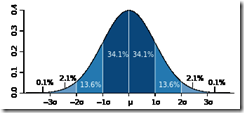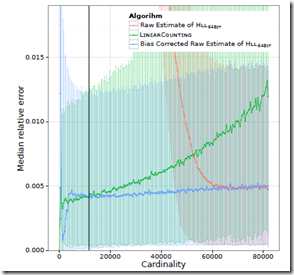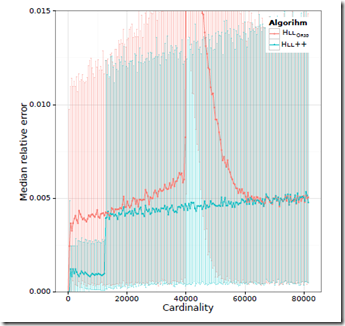HyperLogLog in Practice: Algorithmic Engineering of a State of The Art Cardinality Estimation Algorithm
HyperLogLog参考下面这篇blog,
http://blog.codinglabs.org/articles/algorithms-for-cardinality-estimation-part-iv.html
为何LLC在基数不大的时候会误差比较大?
直观上,由于基数不大时,会有很多空桶,而最终结果是求平均值,这个值对离群值(这里的0)非常敏感
那么重理论上看,为何误差比较大?
LLC的渐近标准误差为![]() ,看上去只是和桶数m有关,为何还和基数大小有关?
,看上去只是和桶数m有关,为何还和基数大小有关?
关键就是理解渐近标准误差,
标准误差,(个人理解)
对于估计,真实值和预测值之间一定有误差的,这种误差往往符合高斯分布(根据中心极限定理)
而高斯分布的参数![]() ,就是表示标准误差,因为这个参数表示高斯分布的宽窄,所以
,就是表示标准误差,因为这个参数表示高斯分布的宽窄,所以![]() 越小,表示高斯分布越收拢,即越多的预测值会更接近均值
越小,表示高斯分布越收拢,即越多的预测值会更接近均值 
所以标准误差是可以用来衡量模型预测质量好坏的,所以如果LLC的标准误差为![]() ,那么该算法的误差只和桶数m相关
,那么该算法的误差只和桶数m相关
但是这里“渐近”两个字,表示只有当基数n趋向于无穷大,标准差才趋向于![]()
这就解释了前面的问题
所以解决这个问题两个改进算法,
Adaptive Counting,简单的想法,在n比较小的时候使用linear counting,n比较大的时候用LLC
HyperLogLog Counting,比较复杂的方法,参考“HyperLogLog: the analysis of a near-optimal cardinality estimation algorithm”
基本的改进是使用调和平均数替代几何平均数,以减少对离群值的敏感性
---------------------------------------------------------------------------------------------------------------------------------------------------------------
传统的cardinality统计的方法过于耗费内存, 所以有很多近似的方法以比较低的资源耗费来解决这个问题
在Goolge,每天都会有如下数据分析系统需要对非常大的数据集做cardinality估计,所以google对HyperLogLog做了一系列的improvement。
At Google, various data analysis systems such as Sawzall [15], Dremel [13] and PowerDrill [9] estimate the cardinality of very large data sets every day, for example to determine the number of distinct search queries on google.com over a time period.
Google做了一系列的实验对比,从准确率上来看,Linear counting是最好的,所以当数据量不大的时候首选
但是当基数的取值很大的时候,空间效率上看是有问题的,所以还是选择准确率稍差的HLLC
算法设计的Goal是,
Therefore, the key requirements for a cardinality estimation algorithm can be summarized as follows:
• Accuracy.
For a fixed amount of memory, the algorithm should provide as accurate an estimate as possible. Especially for small cardinalities, the results
should be near exact.
• Memory efficiency.
The algorithm should use the available memory efficiently and adapt its memory usage to the cardinality. That is, the algorithm should use less
than the user-specified maximum amount of memory if the cardinality to be estimated is very small.
• Estimate large cardinalities.
Multisets with cardinalities well beyond 1 billion occur on a daily basis, and it is important that such large cardinalities can be estimated with reasonable accuracy.
• Practicality.
The algorithm should be implementable and maintainable.
HLLC算法
HLLC前面的步骤都是一样,只是最后的计算公式,用调和平均数
并且在实现的时候做了如下的优化,主要是指n很小和很大时,做些特殊化处理
1. Initialization of registers.
The registers are initialized to 0 instead of ![]() to avoid the result 0 for n << mlogm where n is the cardinality of the data stream (i.e., the value we are trying to estimate).
to avoid the result 0 for n << mlogm where n is the cardinality of the data stream (i.e., the value we are trying to estimate).
2. Small range correction.
Simulations by Flajolet et. al. show that for ![]() nonlinear distortions appear that need to be corrected.
nonlinear distortions appear that need to be corrected.
Thus, for this range LinearCounting [16] is used.
3. Large range corrections.
When n starts to approach ![]() , hash collisions become more and more likely (due to the 32 bit hash function). To account for this, a correction is used.
, hash collisions become more and more likely (due to the 32 bit hash function). To account for this, a correction is used.
Google对HLLC的提高
1. Using a 64 Bit Hash Function
这个很容易理解,google需要处理的cardinalities beyond 1 billion,所以原来的32bit不够
2.Estimating Small Cardinalities
对于很小的cardinalities,之前的处理是,当![]() 就使用Linear counting
就使用Linear counting
这里提出一种bias-corrected的方法,文章中实验如下,

Our experiments show that at the latest for n > 5m the correction does no longer reduce the error significantly.
所以在n> 5m的时候,直接用HLLC就ok
但是当n<5m时,文章中试图用他们的实验数据去把bias修正掉
再次测试结果是,尽管这样,在n很小的情况下,仍然是Linear counting的效果比较好 
所以最终的逻辑是
当n<5m时,会优先使用bias-corrected的方法, 只有当出现空桶,即n很小的情况下,才使用linear counting
3.Sparse Representation
这组优化关键就是更加节省空间,其实HLLC对空间的耗费本身就不高,但是由于google的基数实在太大导致桶数也非常大, 所以再小的值乘上个超大的基数也扛不住
优化都比较简单,
1. 当n<<m,情况下,即有很多空桶,那不用记录每个桶的情况,只需要记录有数据的桶,就是稀疏表示,![]()
2. 在稀疏表示的情况下,可以使用更多位数来表示![]() ,以达到更高的precision
,以达到更高的precision
3. 进一步压缩稀疏表示
4. 在linear counting的情况下,其实不需要记录![]()
最终HLLC和google的HLLC++的数据对比





 浙公网安备 33010602011771号
浙公网安备 33010602011771号